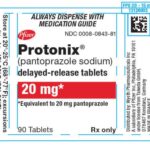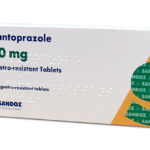Why Take Pantoprazole First Thing In The Morning?

Pantoprazole, sold under the brand name Protonix among others, is a medication used to treat damage from gastroesophageal reflux disease (GERD), a condition in which backward flow of acid from the stomach causes heartburn and possible injury of the esophagus (the tube between the throat and stomach) in adults and children 5 years of age and older.
Pantoprazole is used to allow the esophagus to heal and prevent further damage to the esophagus in adults with GERD. It is also used to treat conditions where the stomach produces too much acid, such as Zollinger-Ellison syndrome in adults. Pantoprazole is in a class of medications called proton-pump inhibitors. It works by decreasing the amount of acid made in the stomach.
How Does Pantoprazole Work?
Proton pump inhibitors like pantoprazole block a chemical system in the body called the hydrogen-potassium adenosine triphosphatase enzyme system, also known as the proton pump. These proton pumps line the stomach and are responsible for the production of hydrochloric acid, which is one of the main components of stomach acid. Proton pump inhibitors work by stopping the cells in the lining of the stomach from producing too much acid. When the amount of acid in the stomach is reduced, existing ulcers have a chance to heal, new ulcers are prevented from forming, and acid reflux symptoms, such as heartburn and regurgitation, are reduced.
How should I use pantoprazole?
Take pantoprazole exactly as prescribed by your doctor. Follow all directions on your prescription label and read all medication guides or instruction sheets. Use the medicine exactly as directed.
Use the lowest dose for the shortest amount of time needed to treat your condition.
Pantoprazole is taken by mouth (oral) or given as an infusion into a vein (injection). A healthcare provider may teach you how to properly use the injection by yourself.
Pantoprazole tablets are taken by mouth, with or without food. The oral granules should be taken 30 minutes before a meal.
Do not crush, chew, or break the tablet. Swallow it whole. The oral granules should be mixed with applesauce or apple juice and given either by mouth or through a nasogastric (NG) tube. Read and carefully follow any Instructions for Use provided with your medicine. Ask your doctor or pharmacist if you have any questions.
Why Take Pantoprazole First Thing In The Morning?
The best time to take pantoprazole once a day, is first thing in the morning. If you take pantoprazole twice a day, take 1 dose in the morning and 1 dose in the evening. It’s best to take pantoprazole an hour before a meal. Swallow tablets whole with a drink of water.
Use this medicine for the full prescribed length of time, even if your symptoms quickly improve. Call your doctor if your symptoms do not improve or if they get worse while you are using this medicine. Pantoprazole can cause false results with certain medical tests. Tell the doctor or laboratory staff that you are using this medicine.
Pantoprazole may also affect a drug-screening urine test and you may have false results. Tell the laboratory staff that you use this medicine.
What are side effects of pantoprazole?
Common side effects of pantoprazole include:
• Headache
• Abdominal pain
• Facial puffiness
• Generalized swelling (edema)
• Chest pain
• Diarrhea
• Constipation
• Itching
• Rash
• Gas
• High blood sugar (hyperglycemia)
• Nausea
• Vomiting
• Photosensitivity
Other side effects of pantoprazole include:
• Skin swelling
• Atrophic gastritis
• Anterior ischemic optic neuropathy
• Hepatocellular damage leading to hepatic failure
• Interstitial nephritis
• Pancreatitis
• Low white blood cell, red blood cell, and platelet count
• Muscle wasting (rhabdomyolysis)
• Risk of a severe allergic reaction (anaphylaxis)
• Stevens-Johnson syndrome
• Fatal toxic epidermal necrolysis
• Erythema multiforme
Postmarketing side effects of pantoprazole reported include:
• Weakness
• Fatigue
• Feeling unwell (malaise)
• Hepatocellular damage leading to jaundice and hepatic failure
• Agranulocytosis, pancytopenia
• Taste disorders (loss of taste, changes in taste)
• Weight changes
• Low blood sodium (hyponatremia)
• Low blood magnesium
• Bone fracture
• Hallucinations
• Confusion
• Insomnia
• Drowsiness
• Interstitial nephritis
• Severe dermatologic reactions (some fatal), including erythema multiforme, Stevens-Johnson syndrome, and toxic epidermal necrolysis (some fatal), as well as angioedema (Quincke edema)
• Cutaneous and systemic lupus erythematosus
• Cyanocobalamin (Vitamin B-12) deficiency
• Clostridium difficile-associated diarrhea
This document does not contain all possible side effects and others may occur. Check with your physician for additional information about side effects.
Ask your pharmacist or doctor for a copy of the manufacturer’s information for the patient.





